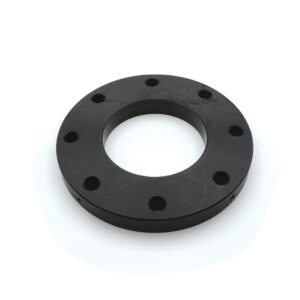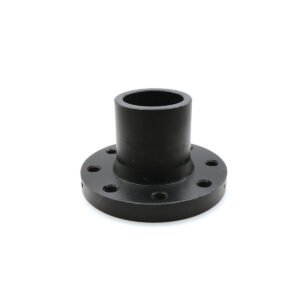HDPE flanged fittings are a key element in conveying pressurized fluids—especially in medium and large diameters—where permanent joints (butt fusion or electrofusion) or threaded connections no longer suffice and periodic access for maintenance, equipment replacement, or network reconfiguration is essential. The basic structure comprises two main components: a polyethylene stub end or flange adaptor and a drilled steel backing ring that, with bolts and nuts, apply a uniform compressive force to the gasket. This design provides both high-grade sealing and easy separation—features relied upon in potable water lines, pumped sewage, mineral slurries, and hot/cold loops in process industries.
Technical and economic advantages
- Stable sealing under pressure cycles
Because polyethylene has a lower modulus of elasticity than steel, it exhibits slight creep after bolt load is applied; nevertheless, the combination of a rigid metal ring and a suitable gasket (EPDM for water, NBR for hydrocarbons, PTFE for corrosive media) keeps the contact surface under constant compressive stress. This property controls leakage even during sudden hydraulic shocks and pump start/stop cycles. - Superior chemical compatibility
The polyethylene body resists free chlorine, dilute organic and mineral acids, saline solutions, and a wide range of fuels. Therefore, an HDPE flange joint can serve as a safe transition point between HDPE networks and equipment made of stainless steel, ductile iron, UPVC, or GRP without concern for galvanic corrosion. - Tolerance of mechanical and thermal stresses
Stub ends in SDR11 to SDR17 per ISO 4427-1 withstand allowable pressures of 8 to 16 bar at the reference temperature of 20 °C. With rising temperature (e.g., 40 °C), the allowable pressure decreases by about 20%; however, the steel backing ring compensates for this stiffness loss and prevents ovalization of the mouth. - Ease of disassembly and inspection
In gas pressure-reduction centers or water pumping stations, periodic inspection of valves is common. A flanged joint allows you to remove a valve or pump by loosening a few nuts and then reinstall it after overhaul, whereas butt fusion would require cutting the pipe and re-welding.
Component classification and standards
| Connection part | Common material | Dimensional standard | Pressure class (bar) |
|---|---|---|---|
| Short stub end | PE100, SDR11 or 13.6 | ISO 9623 / EN 1092-3 | PN10 – PN16 |
| Backing ring | Carbon steel ST37 with epoxy coating, or stainless 304/316 | EN 1092-1 (Type 02) or ANSI B16.5 (Class 150) | Depending on ring thickness, up to PN25 |
| Flat gasket | EPDM, NBR, PTFE | EN 1514-1 / ASME B16.21 | Per fluid and temperature |
| Bolts & nuts | Hot-dip galvanized class 8.8 or stainless A2-70 | ISO 4017 / ASTM A193 | Torque per diameter |
Selecting the flange class
The steel flange class must at least match the network design pressure. For example, in a municipal water network PN10, using an ANSI Class 150 ring is recommended, as it provides an equivalent pressure capability of 19 bar at 20 °C and thus a sufficient safety margin. In slurry-transfer projects with higher pressure spikes, Class 300 rings or PN25 are used.
Step-by-step installation method
- Pipe cutting and preparation: The pipe end must be square to the axis and free of burrs. Using a scraper on the outer surface removes the oxide layer and improves the quality of the stub-end weld.
- Butt-fusing the stub end: Heater temperature 220 ± 10 °C and fusion pressure 0.15 N/mm² are common for PE100. Heating/soak and cooling times depend on wall thickness; for example, for 225 mm diameter, 14 s heating and 6 min pressure-holding are sufficient.
- Assembling ring and gasket: After full cooling, slide the steel ring onto the back of the stub lip. Center a flat gasket without wrinkles on the mating flange face.
- Cross-pattern bolt tightening: Apply torque in three passes: 30%, 60%, then 100% of the recommended final value. The table below shows sample reference values for water at 20 °C.
| Bolt diameter (mm) | Final torque (N·m) for steel ring / EPDM gasket |
|---|---|
| M12 | 35 |
| M16 | 80 |
| M20 | 160 |
| M24 | 270 |
| M27 | 400 |
- Pressure test: Perform a hydrostatic test at 1.5× the operating pressure for at least 30 minutes. Any pressure drop indicates leakage or loose joints that must be corrected before commissioning.
Design and operation notes
- Line alignment: Angular deviation over 1.5° imposes significant stress on the gasket and reduces sealing life. In buried lines, use a thrust block near changes of direction close to the flange.
- Longitudinal expansion compensation: The thermal expansion coefficient of polyethylene (0.19 mm/m·°C) is 8× that of steel. In long pipelines where one end is flanged and the other lacks a sliding joint, include an expansion loop or pipe bend to prevent transferring stress to the bolts.
- Gasket selection: Above 60 °C, EPDM and NBR lose performance; PTFE or reinforced graphite gaskets are appropriate.
- Periodic torque check: In lines with severe thermal cycling (e.g., alternating hot and cold water sprays), check bolt torque every six months to compensate for material creep.
Key applications
- County water pumping stations: connecting a steel manifold to an HDPE collector with PN16 flange, 315 mm diameter.
- Seawater desalination units: joining an HDPE suction line Ø630 mm to a super-duplex centrifugal pump with a Class 300 ring and PTFE gasket.
- Sprinkler-irrigation filtration packages: bolted SDR17 mechanical flange adaptor with NBR O-ring for quick relocation on the farm.
- Tailings slurry transfer: abrasion-resistant HDPE Ø450 mm connected to an armored steel pipe via a long-pattern stub end and thick reinforced ring.
Common market terms and names
- Short/Long welding flange (Stub End Short/Long): The long type is recommended for higher pressures and larger diameters due to its longer barrel.
- Backing ring: A drilled steel ring; in workshop jargon also known as “گردبر”.
- Lap joint flange: Combination of a polyethylene stub and a loose ring that slides on it; in projects with frequent changes of direction, it helps reduce stress.
- Mechanical flange adaptor: A polyethylene body with bush and O-ring that clamps on the pipe without welding; a popular option in farm irrigation due to fast installation.
In closing, Tamam Baha—recognized as a reliable supplier of HDPE flanged fittings to international standards—offers a broad portfolio of stub ends, carbon- and stainless-steel rings, specialty gaskets, and coated bolts in sizes from 63 to 1200 mm. While the brand focuses on competitive pricing and fast delivery for projects across the Middle East and beyond, customers can source equivalent products from other reputable local manufacturers as well; Tamam Baha’s technical team is ready to compare specifications and help you choose the optimal option for your project.



